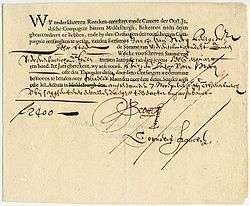Dutch East India Company
 | |
| Public company | |
| Industry | Trade |
| Fate | Dissolved |
| Founded | 20 March 1602[1] |
| Defunct | 31 December 1799 |
| Headquarters | East India House, Amsterdam and Oost-Indisch Huis, Middelburg, Dutch Republic |

The United East Indian Company (Dutch: Vereenigde Oost-Indische Compagnie; VOC), referred to by the British as the Dutch East India Company,[2] was originally established as a chartered company in 1602, when the Dutch government granted it a 21-year monopoly on Dutch spice trade. It is often considered to have been the first multinational corporation in the world [3] and it was the first company to issue stock.[4] The largest and most valuable corporation in history,[5] it possessed quasi-governmental powers, including the ability to wage war, imprison and execute convicts,[6] negotiate treaties, strike its own coins, and establish colonies.[7]
Statistically, the VOC eclipsed all of its rivals in the Asia trade. Between 1602 and 1796 the VOC sent almost a million Europeans to work in the Asia trade on 4,785 ships, and netted for their efforts more than 2.5 million tons of Asian trade goods. By contrast, the rest of Europe combined sent only 882,412 people from 1500 to 1795, and the fleet of the English (later British) East India Company, the VOC's nearest competitor, was a distant second to its total traffic with 2,690 ships and a mere one-fifth the tonnage of goods carried by the VOC. The VOC enjoyed huge profits from its spice monopoly through most of the 17th century.[8]
Having been set up in 1602, to profit from the Malukan spice trade, in 1619 the VOC established a capital in the port city of Jayakarta changing the name to Batavia (now Jakarta). Over the next two centuries the Company acquired additional ports as trading bases and safeguarded their interests by taking over surrounding territory.[9] It remained an important trading concern and paid an 18% annual dividend for almost 200 years.[10]
Due to structural changes, the Fourth Anglo-Dutch War and French invasion of the Netherlands, the company was nationalised in 1800,[11] its possessions and the debt being taken over by the government of the Dutch Batavian Republic. The VOC's territories became the Dutch East Indies and were expanded over the course of the 19th century to include the whole of the Indonesian archipelago, and in the 20th century would form the Republic of Indonesia.
History
Background
Before the Dutch Revolt, Antwerp had played an important role as a distribution centre in northern Europe. However, after 1591 the Portuguese used an international syndicate of the German Fuggers and Welsers, and Spanish and Italian firms, that used Hamburg as its northern staple port to distribute their goods, thereby cutting Dutch merchants out of the trade.
At the same time, the Portuguese trade system was unable to increase supply to satisfy growing demand, in particular the demand for pepper. Demand for spices was relatively inelastic, and therefore each lag in the supply of pepper caused a sharp rise in pepper prices.
In addition, as the Portuguese crown had been united in a personal union with the Spanish crown in 1580, with which the Dutch Republic was at war, the Portuguese Empire became an appropriate target for Dutch military incursions. These three factors motivated Dutch merchants to enter the intercontinental spice trade themselves. Further, a number of Dutchmen like Jan Huyghen van Linschoten and Cornelis de Houtman obtained first hand knowledge of the "secret" Portuguese trade routes and practices, thereby providing opportunity.[12]
The stage was thus set for Houtman's 1595 four-ship exploratory expedition to Banten, the main pepper port of West Java, where they clashed with both the Portuguese and indigenous Indonesians. Houtman's expedition then sailed east along the north coast of Java, losing twelve crew to a Javanese attack at Sidayu and killing a local ruler in Madura. Half the crew were lost before the expedition made it back to the Netherlands the following year, but with enough spices to make a considerable profit.[13]
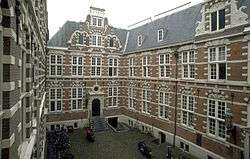
In 1598, an increasing number of fleets were sent out by competing merchant groups from around the Netherlands. Some fleets were lost, but most were successful, with some voyages producing high profits. In March 1599, a fleet of eight ships under Jacob van Neck was the first Dutch fleet to reach the 'Spice Islands' of Maluku, the source of pepper, cutting out the Javanese middlemen. The ships returned to Europe in 1599 and 1600 and the expedition made a 400 percent profit.[13]
In 1600, the Dutch joined forces with the Muslim Hituese on Ambon Island in an anti-Portuguese alliance, in return for which the Dutch were given the sole right to purchase spices from Hitu.[14] Dutch control of Ambon was achieved when the Portuguese surrendered their fort in Ambon to the Dutch-Hituese alliance. In 1613, the Dutch expelled the Portuguese from their Solor fort, but a subsequent Portuguese attack led to a second change of hands; following this second reoccupation, the Dutch once again captured Solor, in 1636.[14]
East of Solor, on the island of Timor, Dutch advances were halted by an autonomous and powerful group of Portuguese Eurasians called the Topasses. They remained in control of the Sandalwood trade and their resistance lasted throughout the 17th and 18th century, causing Portuguese Timor to remain under the Portuguese sphere of control.[15][16]
Formation (1602)
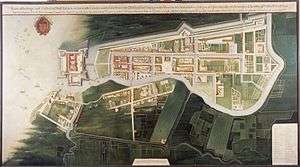
At the time, it was customary for a company to be set up only for the duration of a single voyage, and to be liquidated upon the return of the fleet. Investment in these expeditions was a very high-risk venture, not only because of the usual dangers of piracy, disease and shipwreck, but also because the interplay of inelastic demand and relatively elastic supply[17] of spices could make prices tumble at just the wrong moment, thereby ruining prospects of profitability. To manage such risk the forming of a cartel to control supply would seem logical. The English had been the first to adopt this approach, by bundling their resources into a monopoly enterprise, the English East India Company in 1600, thereby threatening their Dutch competitors with ruin.[18]
In 1602, the Dutch government followed suit, sponsoring the creation of a single "United East Indies Company" that was also granted monopoly over the Asian trade. With a capital of 6,440,200 guilders,[19] the charter of the new company empowered it to build forts, maintain armies, and conclude treaties with Asian rulers. It provided for a venture that would continue for 21 years, with a financial accounting only at the end of each decade.[18]
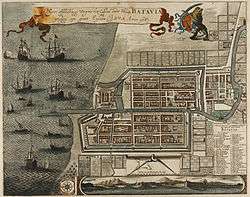
In February 1603, the Company seized the Santa Catarina (ship) off Singapore, a 1500-ton Portuguese merchant carrack.[20] She was such a rich prize that her sale proceeds increased the capital of the V.O.C by more than 50%.[21]
In that same year the first permanent Dutch trading post in Indonesia was established in Banten, West Java and in 1611, another was established at Jayakarta (later "Batavia" and then "Jakarta").[22] In 1610, the VOC established the post of Governor General to more firmly control their affairs in Asia. To advise and control the risk of despotic Governors General, a Council of the Indies (Raad van Indië) was created. The Governor General effectively became the main administrator of the VOC's activities in Asia, although the Heeren XVII, a body of 17 shareholders representing different chambers, continued to officially have overall control.[14]
VOC headquarters were located in Ambon during the tenures of the first three Governors General (1610–1619), but it was not a satisfactory location. Although it was at the centre of the spice production areas, it was far from the Asian trade routes and other VOC areas of activity ranging from Africa to India to Japan.[23][24] A location in the west of the archipelago was thus sought; the Straits of Malacca were strategic, but had become dangerous following the Portuguese conquest and the first permanent VOC settlement in Banten was controlled by a powerful local ruler and subject to stiff competition from Chinese and English traders.[14]

In 1604, a second English East India Company voyage commanded by Sir Henry Middleton reached the islands of Ternate, Tidore, Ambon and Banda; in Banda, they encountered severe VOC hostility, which saw the beginning of Anglo-Dutch competition for access to spices.[22] From 1611 to 1617, the English established trading posts at Sukadana (southwest Kalimantan), Makassar, Jayakarta and Jepara in Java, and Aceh, Pariaman and Jambi in Sumatra which threatened Dutch ambitions for a monopoly on East Indies trade.[22]
Diplomatic agreements in Europe in 1620 ushered in a period of co-operation between the Dutch and the English over the spice trade.[22] This ended with a notorious, but disputed incident, known as the 'Amboyna massacre', where ten Englishmen were arrested, tried and beheaded for conspiracy against the Dutch government.[25] Although this caused outrage in Europe and a diplomatic crisis, the English quietly withdrew from most of their Indonesian activities (except trading in Bantam) and focused on other Asian interests.
Growth
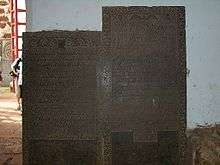
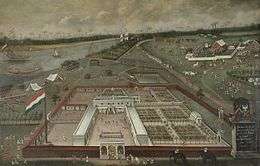
In 1619, Jan Pieterszoon Coen was appointed Governor-General of the VOC. He saw the possibility of the VOC becoming an Asian power, both political and economic. On 30 May 1619, Coen, backed by a force of nineteen ships, stormed Jayakarta, driving out the Banten forces; and from the ashes established Batavia as the VOC headquarters. In the 1620s almost the entire native population of the Banda Islands was driven away, starved to death, or killed in an attempt to replace them with Dutch plantations.[26] These plantations were used to grow cloves and nutmeg for export. Coen hoped to settle large numbers of Dutch colonists in the East Indies, but implementation of this policy never materialised, mainly because very few Dutch were willing to emigrate to Asia.[27]
Another of Coen's ventures was more successful. A major problem in the European trade with Asia at the time was that the Europeans could offer few goods that Asian consumers wanted, except silver and gold. European traders therefore had to pay for spices with the precious metals, which were in short supply in Europe, except for Spain and Portugal. The Dutch and English had to obtain it by creating a trade surplus with other European countries. Coen discovered the obvious solution for the problem: to start an intra-Asiatic trade system, whose profits could be used to finance the spice trade with Europe. In the long run this obviated the need for exports of precious metals from Europe, though at first it required the formation of a large trading-capital fund in the Indies. The VOC reinvested a large share of its profits to this end in the period up to 1630.[28]
The VOC traded throughout Asia. Ships coming into Batavia from the Netherlands carried supplies for VOC settlements in Asia. Silver and copper from Japan were used to trade with India and China for silk, cotton, porcelain, and textiles. These products were either traded within Asia for the coveted spices or brought back to Europe. The VOC was also instrumental in introducing European ideas and technology to Asia. The Company supported Christian missionaries and traded modern technology with China and Japan. A more peaceful VOC trade post on Dejima, an artificial island off the coast of Nagasaki, was for more than two hundred years the only place where Europeans were permitted to trade with Japan.[29] When the VOC tried to military force Ming dynasty China to open up to Dutch trade, the Chinese defeated the Dutch in a war over the Penghu islands from 1623-1624 and forced the VOC to abandon Penghu for Taiwan. The Chinese defeated the VOC again at the Battle of Liaoluo Bay in 1633.
The Vietnamese Nguyen Lords defeated the VOC in a 1643 battle during the Trịnh–Nguyễn War, blowing up a Dutch ship. The Cambodians defeated the VOC in a war from 1643-44 on the Mekong River.
In 1640, the VOC obtained the port of Galle, Ceylon, from the Portuguese and broke the latter's monopoly of the cinnamon trade. In 1658, Gerard Pietersz. Hulft laid siege to Colombo, which was captured with the help of King Rajasinghe II of Kandy. By 1659, the Portuguese had been expelled from the coastal regions, which were then occupied by the VOC, securing for it the monopoly over cinnamon. To prevent the Portuguese or the English from ever recapturing Sri Lanka, the VOC went on to conquer the entire Malabar Coast from the Portuguese, almost entirely driving them from the west coast of India. When news of a peace agreement between Portugal and the Netherlands reached Asia in 1663, Goa was the only remaining Portuguese city on the west coast.[30]
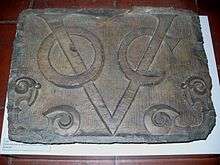
In 1652, Jan van Riebeeck established an outpost at the Cape of Good Hope (the southwestern tip of Africa, now Cape Town, South Africa) to re-supply VOC ships on their journey to East Asia. This post later became a full-fledged colony, the Cape Colony, when more Dutch and other Europeans started to settle there.
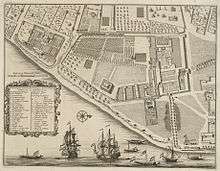
VOC trading posts were also established in Persia, Bengal, Malacca, Siam, Canton, Formosa (now Taiwan), as well as the Malabar and Coromandel coasts in India. In 1662, however, Koxinga expelled the Dutch from Taiwan[31] (see History of Taiwan).
In 1663, the VOC signed "Painan Treaty" with several local lords in the Painan area that were revolting against the Aceh Sultanate. The treaty resulted in VOC to build a trading post in the area and eventually monopolise the trade there, especially in gold trade.[32]
By 1669, the VOC was the richest private company the world had ever seen, with over 150 merchant ships, 40 warships, 50,000 employees, a private army of 10,000 soldiers, and a dividend payment of 40% on the original investment.[33]
Many of the VOC employees inter-mixed with the indigenous peoples and expanded the population of Indos in pre-colonial history [34][35]
Reorientation
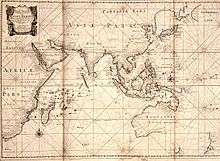
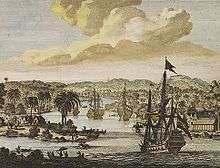
Around 1670, two events caused the growth of VOC trade to stall. In the first place, the highly profitable trade with Japan started to decline. The loss of the outpost on Formosa to Koxinga in the 1662 Siege of Fort Zeelandia and related internal turmoil in China (where the Ming dynasty was being replaced with the Qing dynasty) brought an end to the silk trade after 1666. Though the VOC substituted Bengali for Chinese silk other forces affected the supply of Japanese silver and gold. The shogunate enacted a number of measures to limit the export of these precious metals, in the process limiting VOC opportunities for trade, and severely worsening the terms of trade. Therefore, Japan ceased to function as the lynchpin of the intra-Asiatic trade of the VOC by 1685.[36]
Even more importantly, the Third Anglo-Dutch War temporarily interrupted VOC trade with Europe. This caused a spike in the price of pepper, which enticed the English East India Company (EIC) to aggressively enter this market in the years after 1672. Previously, one of the tenets of the VOC pricing policy was to slightly over-supply the pepper market, so as to depress prices below the level where interlopers were encouraged to enter the market (instead of striving for short-term profit maximisation). The wisdom of such a policy was illustrated when a fierce price war with the EIC ensued, as that company flooded the market with new supplies from India. In this struggle for market share, the VOC (which had much larger financial resources) could wait out the EIC. Indeed, by 1683, the latter came close to bankruptcy; its share price plummeted from 600 to 250; and its president Josiah Child was temporarily forced from office.[37]
However, the writing was on the wall. Other companies, like the French East India Company and the Danish East India Company also started to make inroads on the Dutch system. The VOC therefore closed the heretofore flourishing open pepper emporium of Bantam by a treaty of 1684 with the Sultan. Also, on the Coromandel Coast, it moved its chief stronghold from Pulicat to Negapatnam, so as to secure a monopoly on the pepper trade at the detriment of the French and the Danes.[38] However, the importance of these traditional commodities in the Asian-European trade was diminishing rapidly at the time. The military outlays that the VOC needed to make to enhance its monopoly were not justified by the increased profits of this declining trade.[39]
Nevertheless, this lesson was slow to sink in and at first the VOC made the strategic decision to improve its military position on the Malabar Coast (hoping thereby to curtail English influence in the area, and end the drain on its resources from the cost of the Malabar garrisons) by using force to compel the Zamorin of Calicut to submit to Dutch domination. In 1710, the Zamorin was made to sign a treaty with the VOC undertaking to trade exclusively with the VOC and expel other European traders. For a brief time, this appeared to improve the Company's prospects. However, in 1715, with EIC encouragement, the Zamorin renounced the treaty. Though a Dutch army managed to suppress this insurrection temporarily, the Zamorin continued to trade with the English and the French, which led to an appreciable upsurge in English and French traffic. The VOC decided in 1721 that it was no longer worth the trouble to try to dominate the Malabar pepper and spice trade. A strategic decision was taken to scale down the Dutch military presence and in effect yield the area to EIC influence.[40]
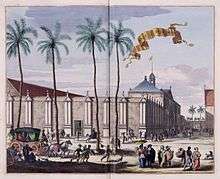
The 1741 Battle of Colachel by Nair warriors of Travancore under Raja Marthanda Varma defeated the Dutch. The Dutch commander Captain Eustachius De Lannoy was captured. Marthanda Varma agreed to spare the Dutch captain's life on condition that he joined his army and trained his soldiers on modern lines. This defeat in the Travancore-Dutch War is considered the earliest example of an organised Asian power overcoming European military technology and tactics; and it signalled the decline of Dutch power in India.[41]
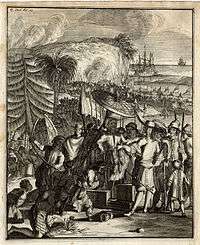
The attempt to continue as before as a low volume-high profit business enterprise with its core business in the spice trade had therefore failed. The Company had however already (reluctantly) followed the example of its European competitors in diversifying into other Asian commodities, like tea, coffee, cotton, textiles, and sugar. These commodities provided a lower profit margin and therefore required a larger sales volume to generate the same amount of revenue. This structural change in the commodity composition of the VOC's trade started in the early 1680s, after the temporary collapse of the EIC around 1683 offered an excellent opportunity to enter these markets. The actual cause for the change lies, however, in two structural features of this new era.
In the first place, there was a revolutionary change in the tastes affecting European demand for Asian textiles, and coffee and tea, around the turn of the 18th century. Secondly, a new era of an abundant supply of capital at low interest rates suddenly opened around this time. The second factor enabled the Company to easily finance its expansion in the new areas of commerce.[42] Between the 1680s and 1720s, the VOC was therefore able to equip and man an appreciable expansion of its fleet, and acquire a large amount of precious metals to finance the purchase of large amounts of Asian commodities, for shipment to Europe. The overall effect was to approximately double the size of the company.[43]
The tonnage of the returning ships rose by 125 percent in this period. However, the Company's revenues from the sale of goods landed in Europe rose by only 78 percent. This reflects the basic change in the VOC's circumstances that had occurred: it now operated in new markets for goods with an elastic demand, in which it had to compete on an equal footing with other suppliers. This made for low profit margins.[44] Unfortunately, the business information systems of the time made this difficult to discern for the managers of the company, which may partly explain the mistakes they made from hindsight. This lack of information might have been counteracted (as in earlier times in the VOC's history) by the business acumen of the directors. Unfortunately by this time these were almost exclusively recruited from the political regent class, which had long since lost its close relationship with merchant circles.[45]
Low profit margins in themselves do not explain the deterioration of revenues. To a large extent the costs of the operation of the VOC had a "fixed" character (military establishments; maintenance of the fleet and such). Profit levels might therefore have been maintained if the increase in the scale of trading operations that in fact took place, had resulted in economies of scale. However, though larger ships transported the growing volume of goods, labour productivity did not go up sufficiently to realise these. In general the Company's overhead rose in step with the growth in trade volume; declining gross margins translated directly into a decline in profitability of the invested capital. The era of expansion was one of "profitless growth".[46]
Concretely: "[t]he long-term average annual profit in the VOC's 1630–70 'Golden Age' was 2.1 million guilders, of which just under half was distributed as dividends and the remainder reinvested. The long-term average annual profit in the 'Expansion Age' (1680–1730) was 2.0 million guilders, of which three-quarters was distributed as dividend and one-quarter reinvested. In the earlier period, profits averaged 18 percent of total revenues; in the latter period, 10 percent. The annual return of invested capital in the earlier period stood at approximately 6 percent; in the latter period, 3.4 percent."[46]
Nevertheless, in the eyes of investors the VOC did not do too badly. The share price hovered consistently around the 400 mark from the mid-1680s (excepting a hiccup around the Glorious Revolution in 1688), and they reached an all-time high of around 642 in the 1720s. VOC shares then yielded a return of 3.5 percent, only slightly less than the yield on Dutch government bonds.[47]
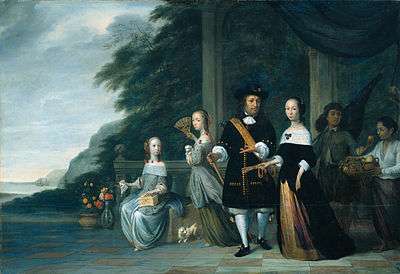 Pieter Cnoll and his wife Cornelia van Nijenrode by Jacob Coeman (1665)
Pieter Cnoll and his wife Cornelia van Nijenrode by Jacob Coeman (1665)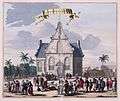 Dutch church at Batavia, 1682
Dutch church at Batavia, 1682 Engraving of Colombo, circa 1680
Engraving of Colombo, circa 1680 Panorama of Ayutthaya in the Bushuis, Amsterdam
Panorama of Ayutthaya in the Bushuis, Amsterdam- Kraak porcelain in a museum in Malacca
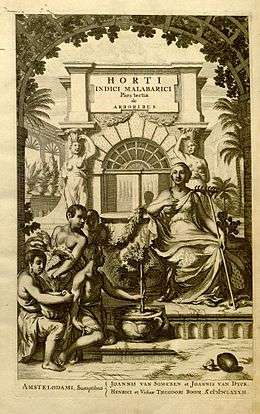 The cover of the Hortus Malabaricus by Hendrik Adriaan van Reede tot Drakenstein
The cover of the Hortus Malabaricus by Hendrik Adriaan van Reede tot Drakenstein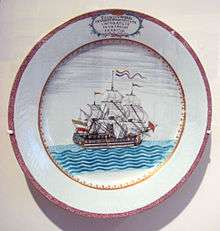 The ship Vryburg on a platter, commissioned 1756
The ship Vryburg on a platter, commissioned 1756 Anonymous painting with Table Mountain in the background, 1762
Anonymous painting with Table Mountain in the background, 1762 The VOC factory at Surat
The VOC factory at Surat
Decline
However, from there on the fortunes of the VOC started to decline. Five major problems, not all of equal weight, can be used to explain its decline in the next fifty years to 1780.[48]
- There was a steady erosion of intra-Asiatic trade because of changes in the Asiatic political and economic environment that the VOC could do little about. These factors gradually squeezed the company out of Persia, Suratte, the Malabar Coast, and Bengal. The company had to confine its operations to the belt it physically controlled, from Ceylon through the Indonesian archipelago. The volume of this intra-Asiatic trade, and its profitability, therefore had to shrink.
- The way the company was organised in Asia (centralised on its hub in Batavia) that initially had offered advantages in gathering market information, began to cause disadvantages in the 18th century, because of the inefficiency of first shipping everything to this central point. This disadvantage was most keenly felt in the tea trade, where competitors like the EIC and the Ostend Company shipped directly from China to Europe.
- The "venality" of the VOC's personnel (in the sense of corruption and non-performance of duties), though a problem for all East-India Companies at the time, seems to have plagued the VOC on a larger scale than its competitors. To be sure, the company was not a "good employer". Salaries were low, and "private-account trading" was officially not allowed. Not surprisingly, it proliferated in the 18th century to the detriment of the company's performance.[49] From about the 1790s onward, the phrase perished under corruption (vergaan onder corruptie, also abbreviated VOC in Dutch) came to summarise the company's future.
- A problem that the VOC shared with other companies was the high mortality and morbidity rates among its employees. This decimated the company's ranks and enervated many of the survivors.
- A self-inflicted wound was the VOC's dividend policy. The dividends distributed by the company had exceeded the surplus it garnered in Europe in every decade but one (1710–1720) from 1690 to 1760. However, in the period up to 1730 the directors shipped resources to Asia to build up the trading capital there. Consolidated bookkeeping therefore probably would have shown that total profits exceeded dividends. In addition, between 1700 and 1740 the company retired 5.4 million guilders of long-term debt. The company therefore was still on a secure financial footing in these years. This changed after 1730. While profits plummeted the bewindhebbers only slightly decreased dividends from the earlier level. Distributed dividends were therefore in excess of earnings in every decade but one (1760–1770). To accomplish this, the Asian capital stock had to be drawn down by 4 million guilders between 1730 and 1780, and the liquid capital available in Europe was reduced by 20 million guilders in the same period. The directors were therefore constrained to replenish the company's liquidity by resorting to short-term financing from anticipatory loans, backed by expected revenues from home-bound fleets.
Despite of all this, the VOC in 1780 remained an enormous operation. Its capital in the Republic, consisting of ships and goods in inventory, totalled 28 million guilders; its capital in Asia, consisting of the liquid trading fund and goods en route to Europe, totalled 46 million guilders. Total capital, net of outstanding debt, stood at 62 million guilders. The prospects of the company at this time therefore need not have been hopeless, had one of the many plans to reform it been taken successfully in hand. However, then the Fourth Anglo-Dutch War intervened. British attacks in Europe and Asia reduced the VOC fleet by half; removed valuable cargo from its control; and devastated its remaining power in Asia. The direct losses of the VOC can be calculated at 43 million guilders. Loans to keep the company operating reduced its net assets to zero.[50]
From 1720 on, the market for sugar from Indonesia declined as the competition from cheap sugar from Brazil increased. European markets became saturated. Dozens of Chinese sugar traders went bankrupt which led to massive unemployment, which in turn led to gangs of unemployed coolies. The Dutch government in Batavia did not adequately respond to these problems. In 1740, rumours of deportation of the gangs from the Batavia area led to widespread rioting. The Dutch military searched houses of Chinese in Batavia for weapons. When a house accidentally burnt down, military and impoverished citizens started slaughtering and pillaging the Chinese community.[51] This massacre of the Chinese was deemed sufficiently serious for the board of the VOC to start an official investigation into the Government of the Dutch East Indies for the first time in its history.
After the Fourth Anglo-Dutch War, the VOC was a financial wreck, and after vain attempts by the provincial States of Holland and Zeeland to reorganise it, was nationalised on 1 March 1796[52] by the new Batavian Republic. Its charter was renewed several times, but allowed to expire on 31 December 1799.[52] Most of the possessions of the former VOC were subsequently occupied by Great Britain during the Napoleonic wars, but after the new United Kingdom of the Netherlands was created by the Congress of Vienna, some of these were restored to this successor state of the old Dutch Republic by the Anglo-Dutch Treaty of 1814.
European discovery of Australia
In terms of world history of geography and exploration, the VOC can be credited with putting most of Australia's coast (then Hollandia Nova and other names) on the world map, between 1606 and 1756.[53] An Australian vintner has used the VOC logo since the late 20th century, having re-registered the company's name for the purpose.[54]
Organization
The VOC had two types of shareholders: the participanten, who could be seen as non-managing members, and the 76 bewindhebbers (later reduced to 60) who acted as managing directors. This was the usual set-up for Dutch joint-stock companies at the time. The innovation in the case of the VOC was, that the liability of not just the participanten, but also of the bewindhebbers was limited to the paid-in capital (usually, bewindhebbers had unlimited liability). The VOC therefore was a limited liability company. Also, the capital would be permanent during the lifetime of the company. As a consequence, investors that wished to liquidate their interest in the interim could only do this by selling their share to others on the Amsterdam Stock Exchange.[55] Confusion of confusions, a 1688 dialogue by the Sephardi Jew Joseph de la Vega analysed the workings of this one-stock exchange.
The VOC consisted of six Chambers (Kamers) in port cities: Amsterdam, Delft, Rotterdam, Enkhuizen, Middelburg and Hoorn. Delegates of these chambers convened as the Heeren XVII (the Lords Seventeen). They were selected from the bewindhebber-class of shareholders.[56]
Of the Heeren XVII, eight delegates were from the Chamber of Amsterdam (one short of a majority on its own), four from the Chamber of Zeeland, and one from each of the smaller Chambers, while the seventeenth seat was alternatively from the Chamber of Middelburg-Zeeland or rotated among the five small Chambers. Amsterdam had thereby the decisive voice. The Zeelanders in particular had misgivings about this arrangement at the beginning. The fear was not unfounded, because in practice it meant Amsterdam stipulated what happened.
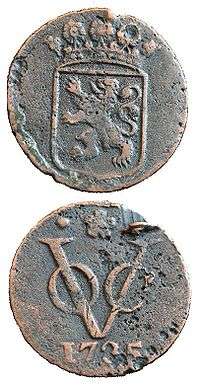
The six chambers raised the start-up capital of the Dutch East India Company:
| Chamber | Capital (Guilders) |
|---|---|
| Amsterdam | 3,679,915 |
| Middelburg | 1,300,405 |
| Enkhuizen | 540,000 |
| Delft | 469,400 |
| Hoorn | 266,868 |
| Rotterdam | 173,000 |
| Total: | 6,424,588 |
The raising of capital in Rotterdam did not go so smoothly. A considerable part originated from inhabitants of Dordrecht. Although it did not raise as much capital as Amsterdam or Middelburg-Zeeland, Enkhuizen had the largest input in the share capital of the VOC. Under the first 358 shareholders, there were many small entrepreneurs, who dared to take the risk. The minimum investment in the VOC was 3,000 guilders, which priced the Company's stock within the means of many merchants.[57]
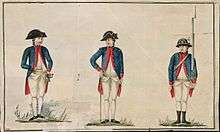
Among the early shareholders of the VOC, immigrants played an important role. Under the 1,143 tenderers were 39 Germans and no fewer than 301 from the Southern Netherlands (roughly present Belgium and Luxembourg, then under Habsburg rule), of whom Isaac le Maire was the largest subscriber with ƒ85,000. VOC's total capitalisation was ten times that of its British rival.

The logo of the VOC consisted of a large capital 'V' with an O on the left and a C on the right leg. It appeared on various corporate items, such as cannons and the coin illustrated above. The first letter of the hometown of the chamber conducting the operation was placed on top (see figure for example of the Amsterdam chamber logo). The flag of the company was orange, white, blue (see Dutch flag) with the company logo embroidered on it.
The Heeren XVII (Lords Seventeen) met alternately 6 years in Amsterdam and 2 years in Middelburg-Zeeland. They defined the VOC's general policy and divided the tasks among the Chambers. The Chambers carried out all the necessary work, built their own ships and warehouses and traded the merchandise. The Heeren XVII sent the ships' masters off with extensive instructions on the route to be navigated, prevailing winds, currents, shoals and landmarks. The VOC also produced its own charts.
In the context of the Dutch-Portuguese War the company established its headquarters in Batavia, Java (now Jakarta, Indonesia). Other colonial outposts were also established in the East Indies, such as on the Maluku Islands, which include the Banda Islands, where the VOC forcibly maintained a monopoly over nutmeg and mace. Methods used to maintain the monopoly involved extortion and the violent suppression of the native population, including mass murder.[58] In addition, VOC representatives sometimes used the tactic of burning spice trees to force indigenous populations to grow other crops, thus artificially cutting the supply of spices like nutmeg and cloves.[59]
VOC outposts
Organization and leadership structures were varied as necessary in the various VOC outposts:
Opperhoofd is a Dutch word (pl. Opperhoofden) which literally means 'supreme chief'. In this VOC context, the word is a gubernatorial title, comparable to the English Chief factor, for the chief executive officer of a Dutch factory in the sense of trading post, as led by a factor, i.e. agent.
- See more at VOC Opperhoofden in Japan
Council of Justice in Batavia
The Council of Justice in Batavia was the appellate court for all the other VOC Company posts in the VOC empire.
Notable VOC ships
- Replicas have been constructed of several VOC ships, marked with an (R)

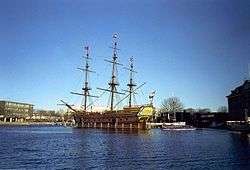
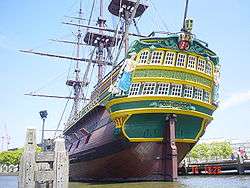

- Akerendam
- Amsterdam (R)
- Arnhem
- Batavia (R)
- Braek
- Concordia
- Dromedaris ("Dromedary camel")
- Duyfken ("Little Dove") (R)
- Eendracht (1615) ("Unity")
- Galias
- Grooten Broeck ("Great Brook")
- Goede Hoop ("Good Hope")
- Gulden Zeepaert ("Golden Seahorse")
- Halve Maen ("Half moon") (R)
- Haerlem[60][61]
- Hoogkarspel
- Heemskerck
- Hollandia
- Klein Amsterdam ("Small Amsterdam")
- Landskroon
- Leeuwerik ("Lark")
- Leyden
- Limmen
- Mauritius
- Meermin ("Mermaid")
- Naerden
- Nieuw Hoorn ("New Hoorn")
- Oliphant ("Elephant")
- Pera ("Perak")
- Prins Willem ("Prince William") (R)
- Reijger
- Ridderschap van Holland ("Knighthood of Holland")
- Rooswijk
- Sardam
- Texel
- Utrecht
- Vergulde Draeck ("Gilded Dragon")
- Vianen
- Vliegende Hollander ("Flying Dutchman")
- Vliegende Swaan ("Flying Swan")
- Walvisch ("Whale")
- Wapen van Hoorn ("Arms of Hoorn")
- Wezel ("Weasel")
- Zeehaen ("Sea Cock")
- Zeemeeuw ("Seagull")
- Zeewijk
- Zuytdorp ("South Village")
See also
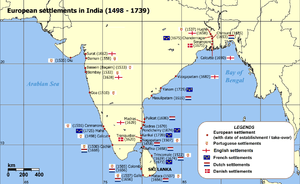
- Chartered companies
- Corporatocracy
- List of trading companies
- Spice wars
- Whampoa anchorage
- Dutch Occupation of the Thiruchendur Temple
Other trade companies of the age of the sail
- Muscovy Company, English trading company chartered in 1555 as the first major chartered joint stock company
- The British East India Company, founded in 1600
- The Danish East India Company, founded in 1616
- The Danish West India Company, founded in 1671
- The Dutch West India Company, founded in 1621
- The Portuguese East India Company, founded in 1628
- The French East India Company, founded in 1664
- The Swedish East India Company, founded in 1731
- The Emden Company, founded 1751
- The Swedish West India Company, founded in 1786
Governors General of the Dutch East India Company
References
- ↑ "The Dutch East India Company (VOC)". Canon van Nederland. Retrieved 19 March 2011.
- ↑ THE DUTCH EAST INDIA COMPANY, European Heritage Project, "The Dutch name was Vereenigde Oost-Indische Compagnie, what literally means the United East Indian Company."
- ↑ http://www.kb.nl/themas/geschiedenis-en-cultuur/koloniaal-verleden/voc-1602-1799 VOC at the National Library of the Netherlands (in Dutch)
- ↑ Mondo Visione web site: Chambers, Clem. "Who needs stock exchanges?" Exchanges Handbook. – retrieved 21 August 2011.
- ↑ Value in 1637 78 million Dutch Guilders - Adjusted to 2012 dollars: $7.4 trillion. The world’s first publicly traded company on the world’s first stock exchange started off as a spice trader. Its competitive edge: The largest fleet shipping goods between Europe and Asia. In the 17th century, it grew tremendously thanks to rampant speculation on the value of tulip bulbs. The so-called tulipmania craze foreshadowed the Internet dot.com bubble, and, like its modern equivalent, it eventually burst. But not before making the company the most valuable in world history. Taylor,B. (2007) The Rise And Fall Of The Largest Corporation In History, Business Insider Nov 2013 , p. 1
- ↑ "Slave Ship Mutiny: Program Transcript". Secrets of the Dead. PBS. 11 November 2010. Retrieved 12 November 2010.
- ↑ Ames, Glenn J. (2008). The Globe Encompassed: The Age of European Discovery, 1500–1700. pp. 102–103.
- ↑ Van Boven, M. W. "Towards A New Age of Partnership (TANAP): An Ambitious World Heritage Project (UNESCO Memory of the World – reg.form, 2002)". VOC Archives Appendix 2, p.14.
- ↑ Vickers (2005), p. 10
- ↑ Ricklefs, M.C. (1991). A History of Modern Indonesia Since c.1300, 2nd Edition. London: MacMillan. p. 110. ISBN 0-333-57689-6.
- ↑ Due to internal structural changes, the effects of the fourth Anglo Dutch War in 1780 and the invasion of the French in 1795 all contributed to created a perfect storm devastating the company's revenue and lending capability. The 'Committee for Affairs Relating to East India Trade and Possessions', instituted by the new Batavian Republic revolutionary government, resulting in the VOC being nationalised on 1 January 1800. The VOC charter, the legal foundation of the enterprise was revoked. Although the state of war in Europe permitted no drastic changes in course as far as shipping and trade to Asia were concerned it spelled the end of the company Balk,L., Van Dijk,F., Kortlang,D., Gaastra,F. Niemeijer,H., Koenders,P. (2007) The Archives of the Dutch East India Company (VOC) and the Local Institutions in Batavia (Jakarta), p. 14
- ↑ De Vries and Van der Woude, p. 383
- 1 2 Ricklefs, M.C. (1991). A History of Modern Indonesia Since c.1300, 2nd Edition. London: MacMillan. p. 27. ISBN 0-333-57689-6.
- 1 2 3 4 Ricklefs, M.C. (1991). A History of Modern Indonesia Since c.1300, 2nd Edition. London: MacMillan. pp. 25–28. ISBN 0-333-57689-6.
- ↑ (Portuguese) Matos, Artur Teodoro de (1974), Timor Portugues, 1515–1769, Lisboa: Instituto Histórico Infante Dom Henrique.
- ↑ (Dutch) Roever, Arend de (2002), De jacht op sandelhout: De VOC en de tweedeling van Timor in de zeventiende eeuw, Zutphen: Walburg Pers.
- ↑ In the medium term, as new suppliers could enter the market. In the short term the supply was, of course, also inelastic.
- 1 2 De Vries and Van der Woude, p. 384–385
- ↑ Bruce, John (1810). Annals of the Honorable East-India Company. Black, Parry, and Kingsbury. p. 28.
- ↑ Boxer, C. R. (1948). Fidalgos in the Far East, 1550–1770. The Hague: Martinus Nijhoff. p. 50.
- ↑ Boyajian, James C. (2008). Portuguese Trade in Asia under the Habsburgs, 1580–1640. JHU Press. p. 151. ISBN 0-8018-8754-2.
- 1 2 3 4 Ricklefs, M.C. (1991). A History of Modern Indonesia Since c.1300, 2nd Edition. London: MacMillan. p. 29. ISBN 0-333-57689-6.
- ↑ Om Prakash, The Dutch East India Company and the Economy of Bengal, 1630–1720 (Princeton University Press, 1985)
- ↑ William De Lange, Pars Japonica: the first Dutch expedition to reach the shores of Japan, (2006)
- ↑ Miller, George (ed.) (1996). To The Spice Islands and Beyond: Travels in Eastern Indonesia. New York: Oxford University Press. xvi. ISBN 967-65-3099-9.
- ↑ Ricklefs, M.C. (1991). A History of Modern Indonesia Since c.1300, 2nd Edition. London: MacMillan. p. 30. ISBN 0-333-57689-6.
- ↑ The Dutch Seaborne Empire 1600–1800, p.218
- ↑ De Vries and Van der Woude, p. 386
- ↑ Ames, Glenn J. (2008). The Globe Encompassed: The Age of European Discovery, 1500–1700. p. 115.
- ↑ "Calling the shots: political interaction".
- ↑ Andrade, Tonio (2005). How Taiwan Became Chinese: Dutch, Spanish and Han Colonization in the Seventeenth Century. Columbia University Press.
- ↑ http://majalah.tempointeraktif.com/id/arsip/1982/07/31/BK/mbm.19820731.BK47129.id.html
- ↑ The share price had appreciated significantly, so in that respect the dividend was less impressive
- ↑ De Witt, D. "The Easternization of the West: The Role of Melaka, the Malay-Indonesian archipelago and the Dutch (VOC). (International seminar by the Melaka State Government, the Malaysian Institute of Historical and Patriotism Studies (IKSEP), the Institute of Occidental Studies (IKON) at the National University of Malaysia (UKM) and the Netherlands Embassy in Malaysia. Malacca, Malaysia, 27 July 2006". Children of the VOC at.
- ↑ Blusse, Leonard. Strange company: Chinese settlers, Mestizo women, and the Dutch in VOC Batavia. (Dordrecht-Holland; Riverton, U.S.A., Foris Publications, 1986. xiii, 302p.) number: 959.82 B659.
- ↑ De Vries and Van der Woude, pp. 434–435
- ↑ De Vries and Van der Woude, pp. 430–433
- ↑ During the Nine Years' War, the French and Dutch companies came to blows on the Indian Subcontinent. The French sent naval expeditions from metropolitan France, which the VOC easily countered. On the other hand, the VOC conquered the important fortress of Pondichéry after a siege of only 16 days by an expedition of 3,000 men and 19 ships under Laurens Pit from Negapatnam in September 1693. The Dutch then made the defenses of the fortress impregnable, which they came to regret when the Dutch government returned it to the French by the Treaty of Ryswick in exchange for tariff concessions in Europe by the French. Chauhuri and Israel, p 424
- ↑ De Vries and Van der Woude, pp. 433–434
- ↑ Chaudhuri and Israel, pp. 428–429
- ↑ However, the VOC had been defeated many times before. On the Indian Subcontinent, the EIC had suffered a resounding defeat from the Mughal forces in its 1689 Mughal War; Chaudhury and Israel, pp. 435–436
- ↑ It was also helpful that the price war with the EIC in the early decade had caused the accumulation of enormous inventories of pepper and spices, which enabled the VOC to cut down on shipments later on, thereby freeing up capital to increase shipments of other goods; De Vries and Van der Woude, p. 436
- ↑ De Vries and Van der Woude, pp. 436–437
- ↑ De Vries and Van der Woude, pp. 437–440
- ↑ De Vries and Van der Woude, pp. 441–442
- 1 2 De Vries and Van der Woude, p. 447
- ↑ De Vries and Van der Woude, p. 448
- ↑ De Vries and Van der Woude, pp. 449–455
- ↑ A particularly egregious example was that of the "Amfioen Society". This was a business of higher VOC-employees that received a monopoly of the opium trade on Java, at a time when the VOC had to pay monopoly prices to the EIC to buy the opium in Bengal; Burger, passim
- ↑ De Vries and Van der Woude, pp. 454–455
- ↑ Kumar, Ann (1997). Java and Modern Europe: Ambiguous Encounters. p. 32.
- 1 2 TANAP, The end of the VOC
- ↑ "The AOTM Landings List 1606 – 1814". history and heritage division of the Australasian Hydrographic Society. Australia on the Map. 6 February 2008. Archived from the original on 2 April 2013. Retrieved 2 April 2013.
After leaving Banda on 18 November 1605, at about the end of March 1606 VOC Captain Willem Janszoon,* Supercargo Jan Lodewijkszoon van Rosingeyn and their crew onboard the Duyfken, charted about 300 km of the west coast of Cape York Peninsula in Queensland. First documented visit of Europeans to the shores of Australia.
- ↑ Tim Treadgold (13 March 2006). "Cross-Breeding". Forbes. Archived from the original on 2 April 2013. Retrieved 2 April 2013.
Michael Wright replicates the Dutch East India Company at his winery in Western Australia.
- ↑ De Vries and Van der Woude, p. 385
- ↑ De Vries and Van der Woude, pp. 384–385
- ↑ Ames, Glenn J. (2008). The Globe Encompassed: The Age of European Discovery, 1500–1700. p. 103.
- ↑ Hanna, Willard A. (1991). Indonesian Banda: Colonialism and its Aftermath in the Nutmeg Islands. Bandanaira: Yayasan Warisan dan Budaya Banda Naira.
- ↑ Ames, Glenn J. (2008). The Globe Encompassed: The Age of European Discovery, 1500–1700. p. 111.
- ↑ Worden, N. van Heyningen, E. and Bickford-Smith, S.: Cape Town: The making of a City Cape Town: David Philip Publishers. ISBN 978-0-86486-435-2
- ↑ "De VOCsite : gegevens VOC-schip Haarlem (1636)".
Further reading
- Ames, Glenn J. The Globe Encompassed: The Age of European Discovery, 1500–1700. Pearson Prentice Hall, 2008.
- Andrade, Tonio. Lost Colony: The Untold Story of China's First Great Victory over the West (Princeton, 2011).
- Blusse, Leonard. An Insane Administration and Insanitary Town: The Dutch East India Company and Batavia (1619–1799) (Springer Netherlands, 1985)
- Borschberg, Peter, Journal, Memorials and Letters of Cornelis Matelieff de Jonge. Security, Diplomacy and Commerce in 17th-Century Southeast Asia (Singapore: NUS Press, 2015) https://www.academia.edu/4302783
- Boxer, Charles Ralph. Jan Compagnie in War and Peace, 1602-1799: A Short History of the Dutch East-India Company (Heinemann Asia, 1979)
- Boxer, Charles R. Jan Compagnie in Japan, 1600–1850: An Essay on the Cultural Artistic and Scientific Influence Exercised by the Hollanders in Japan from the Seventeenth to the Nineteenth Centuries. Den Haag, 1950.
- Boxer, Charles R. The Dutch Seaborne Empire: 1600–1800 (London, 1965.)
- Braam Houckgeest, Andre Everard Van (1798), An authentic account of the embassy of the Dutch East-India Company, to the court of the emperor of China, in the years 1794 and 1795, London: R. Phillips, OCLC 002094734 v.2
- Bruijn, J.R., Femme Gaastra, and I. Schöffer, eds., Dutch-Asiatic shipping in the 17th and 18th centuries. Rijks geschiedkundige publicatiën. Grote serie, vol. 165-167. (The Hague: Nijhoff, 1979, 1987).
- Burger, M. "The Forgotten Gold? The Importance of the Dutch opium trade in the Seventeenth Century", in Eidos. University College Utrecht Academic Magazine. (2003), Issue 2/2003 Utrecht University
- Chaudhuri, K.N., and Israel, J.I. "The English and Dutch East India Companies and the Glorious Revolution of 1688-9", in Jonathan I. Israel, ed. The Anglo-Dutch moment. Essays on the Glorious Revolution and its world impact (Cambridge U.P. 1991), ISBN 0-521-39075-3, pp. 407–438
- De Lange, William. Pars Japonica: the first Dutch expedition to reach the shores of Japan, (Floating World Editions 2006) . ISBN 1-891640-23-2
- Furber, Holden, Rival Empires of Trade in the Orient 1600–1800. Minneapolis, 1976
- Gelderblom, Oscar, and Joost Jonker. "Completing a financial revolution: The finance of the Dutch East India trade and the rise of the Amsterdam capital market, 1595–1612." Journal of Economic History 64.03 (2004): 641-672. online
- Glamann, Kristof., Dutch-Asiatic Trade 1620–1740. (The Hague, 1958)
- Irwin, Douglas A. (January 1991). "Mercantilism as Strategic Trade Policy: The Anglo-Dutch Rivalry for the East India Trade". Journal of Political Economy. 99 (6): 1296–1314. doi:10.1086/261801. JSTOR 2937731.
- Israel, Jonathan I., Dutch Primacy in World Trade 1585–1740. (Oxford, 1989)
- Prakash, Om. The Dutch East India Company and the Economy of Bengal1630-1720 (Princeton University Press, 1985)
- Bhawan Ruangsilp (2007). Dutch East India Company Merchants at the Court of Ayutthaya: Dutch Perceptions of the Thai Kingdom, Ca. 1604-1765. BRILL. ISBN 90-04-15600-3.
- Steengaard, Niels. The Dutch East India Company as an Institutional Innovation (1982)
- Taylor, Jean Gelman. The Social World of Batavia: Europeans and Eurasians in Colonial Indonesia (University of Wisconsin Press, 2nd ed. 2009)
- Theal, George McCall. History of South Africa Under the Administration of the Dutch East India Company 1652 to 1795 Vol. 2. (1897) online.
- Vries, Jan de, and A. van der Woude. The First Modern Economy. Success, Failure, and Perseverance of the Dutch Economy, 1500–1815, (Cambridge University Press, 1997), ISBN 978-0-521-57825-7
- Wills, John Elliot. Pepper, Guns, and Parleys: The Dutch East India Company and China, 1662-1681 (Harvard University Press, 1974)
Dutch sources
- Femme Gaastra, The Dutch East India Company: expansion and decline. Zutphen: Walburg Pers, 2003.
- Femme Gaastra, Particuliere geldstromen binnen het VOC-bedrijf 1640–1795. Leiden: Rijksmuseum Het Koninklijk Penningkabinet, 2002.
- On the eighteenth century as a category of Asian history: Van Leur in retrospect, edited by Leonard Blussé and Femme Gaastra. Aldershot: Ashgate, 1998.
- Ships, sailors and spices: East India companies and their shipping in the 16th, 17th and 18th centuries, ed. by Jaap R. Bruijn and Femme Gaastra. Amsterdam: NEHA, 1993.
- De archieven van de Verenigde Oostindische Compagnie = The archives of the Dutch East India Company: (1602–1795), M.A.P. Meilink-Roelofsz (inventaris); R. Raben en H. Spijkerman. eds. 's-Gravenhage: Sdu Uitgeverij, 1992.
- Dutch-Asiatic shipping in the 17th and 18th centuries, by J. R. Bruijn, Femme Gaastra and I. Schöffer; with assist. from A.C.J. Vermeulen. Three Volumes. Rijks geschiedkundige publicatiën, Grote serie, 165-167. The Hague: Nijhoff, 1979–1987.
- Companies and trade: essays on overseas trading companies during the Ancien Régime, by P. H. Boulle et al.; ed. by Leonard Blussé and Femme Gaastra. The Hague: Leiden University Press, 1981.
- Bewind en Belied bij de VOC: De financiële politik van de bewindhebbers, 1672–1702 by Femme Gaastra. Zutphen: De Walburg Pers, 1968.
External links
| Wikimedia Commons has media related to Dutch East India Company. |
| Dutch Wikisource has original text related to this article: |
- Dutch India — a chronology of Dutch rule in India
- Oldest share — the oldest share in the world (VOC 1606)
- A taste of adventure — The history of spices is the history of trade, The Economist, 17 December 1998.
- Dutch Portuguese Colonial History
- Voyages by VOC ships to Australia
- Why did the Largest Corporation in the World go Broke?
- The history of the Dutch East Indies Company (Lectures at Gresham College, 1 and 8 March 2006)
- Manuscript chart of the Netherlands, VOC, ca.1690 (high resolution zoomable scan)
- Old print of headquarters of V.O.C. ca.1750 (high resolution zoomable scan)
- Death of an East Indiaman
- Towards a New Age of Partnership; a Dutch/Asian/South-African programme of cooperation based on a mutual past (TANAP) - joint archival project of UNESCO, and the Netherlands and Indonesian national archives on the VOC: "An Ambitious World Heritage".
- VOC voyages - online database of voyages of VOC ships
- Atlas of Mutual Heritage - online atlas of VOC settlements
- VOC shipwrecks database
- (Dutch) Database of VOC crew members
- VOC Warfare Website on the military aspects of the history of the VOC
